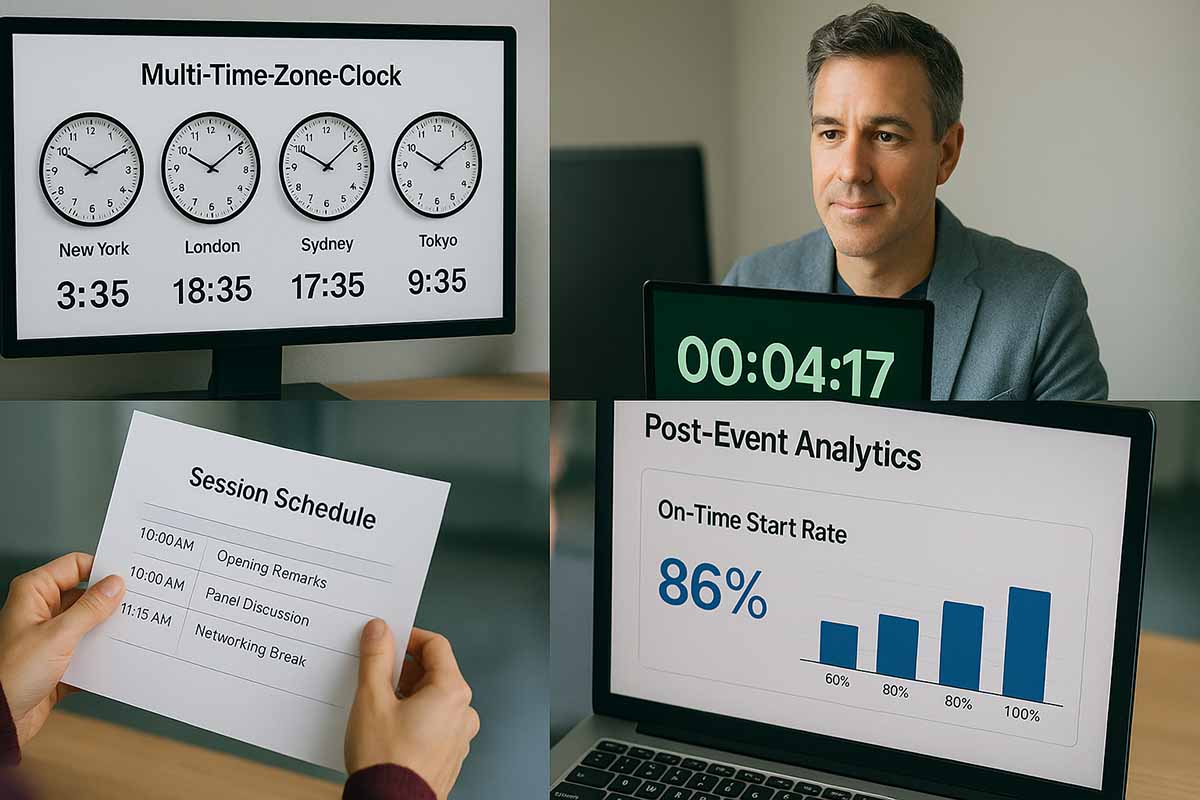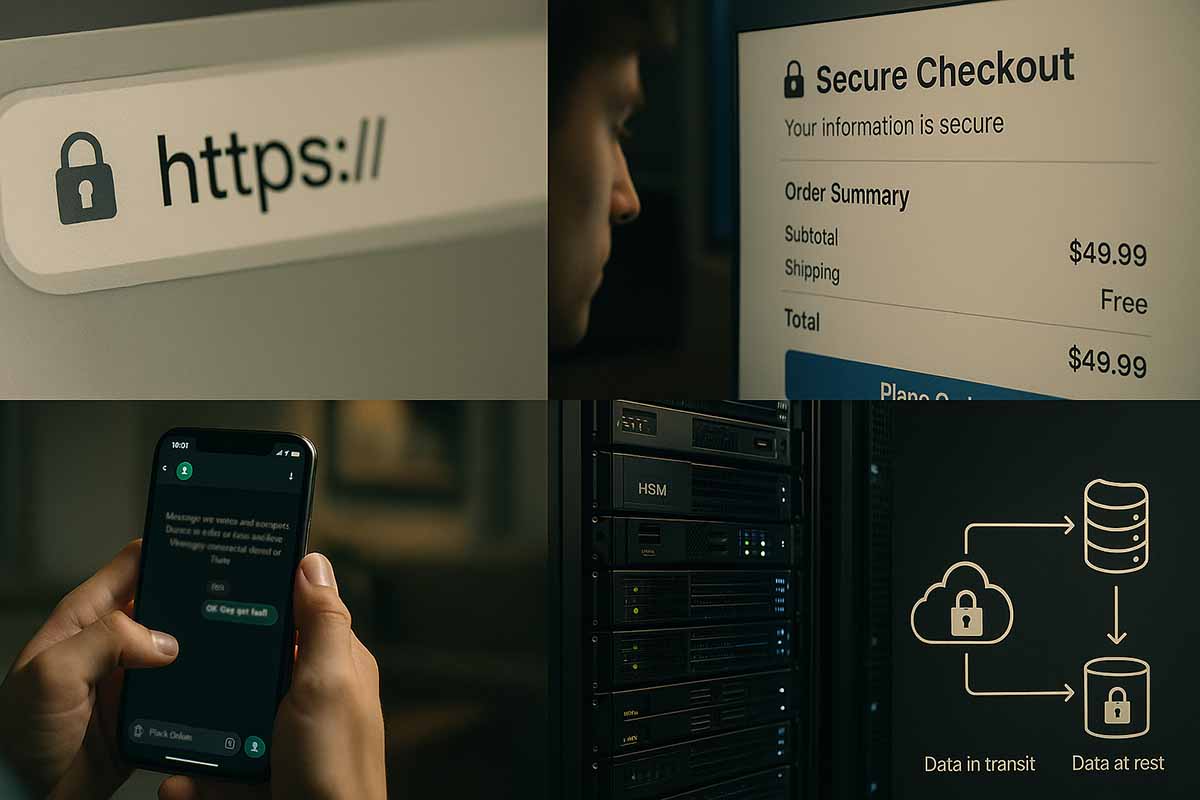
Online Clocks for Successful Virtual Events
Time is often the first thing that gets lost in online events. With multiple time zones, delayed starts, or speeches running over schedule, the participant experience can quickly drop in quality. This is where online clocks prove their value. They may look simple, but they have a major impact on pacing, punctuality, and the professionalism of a program.
Using tools like an online alarm clock or a dedicated online clock helps keep everyone aligned and aware of the schedule. These tools make it easier for hosts, speakers, and technical teams to follow cues, maintain smooth transitions, and ensure sessions begin and end on time.
At a Glance
Benefits: Better flow, clearer cues for each segment, and consistent on-time starts and finishes even with a global audience.
Time as the Backbone of a Program
Even the most engaging content suffers when schedules are not followed. The online clock sets the pulse of the event. Everyone can see when only minutes remain before a Q&A or when it’s time to move to the next session. With a shared reference point for hosts, stage managers, and speakers, dead air is reduced and abrupt cut-offs are avoided.
Synchronizing Across Time Zones
A major challenge for global events is aligning schedules. For example, when it’s 9:00 a.m. in New York, it’s 2:00 p.m. in London, and 10:00 p.m. in Tokyo. Multi–time-zone clocks display equivalent times for each city at a glance. This helps in setting starts, breaks, and networking sessions without confusion.
Daylight saving time adds complexity. Some regions adjust their clocks while others do not. A stage clock set to Coordinated Universal Time (UTC) can serve as a single source of truth. From there, attendees automatically see the local equivalent on their own devices.
How Online Clocks Work
These clocks are often web-based, meaning they can be opened in a browser and easily shared on-screen or embedded in production tools. Modes include countdowns to session start, count-ups for speech duration, and wall clocks synced to a central time server.
To keep time consistent, some solutions use network time protocol or similar synchronization methods. Delays are minimized, and in most cases, only a few milliseconds of difference remain. Simple, lightweight clocks still function well on slower internet connections. Offline fallbacks, such as cached timers, prevent disruption during brief connection drops.
Benefits for Hosts and Attendees
An audience gains confidence when sessions begin at the promised time. For hosts, the role becomes easier with a visible countdown showing when to wrap up a conversation. Attendees benefit from knowing when to return from breaks and how much time remains in the current panel. The result is better attention and stronger feedback.
In large summits, fast handovers are critical. The online clock signals when to start music, remove slides, and introduce the next speaker. The program flows more smoothly, and momentum is preserved.
Types of Clocks Useful in Production
Several clock formats serve different purposes:
- Real-time wall clocks for general reference
- Stage countdowns visible only to production and speakers
- Speaker timers with color cues: green to start, yellow for 2 minutes left, red for 30 seconds left
- Multi–time-zone boards in green rooms or shared dashboards
For breakout rooms, a mini countdown at the top of the screen is effective. It quietly reminds participants when rotations are near. Networking roulette benefits from short-cycle timers to keep exchanges balanced and fair.
A Short Production Story
A global product briefing brought together 600 participants from Europe, North America, and East Asia. Days before the event, the team rehearsed with a shared stage clock. On the event day, the keynote speaker from London had 18 minutes. When the yellow cue appeared, she cut one example and finished on time. The video bumper rolled to the second, and the Q&A began exactly as scheduled. Every prepared question made it into the session.
Accessibility and Inclusive Experience
Not all participants follow a host’s rapid delivery easily. Clear timers and audio cues help those not always looking at the screen. Choose high-contrast displays for readability and avoid distracting flashing animations. Fonts should be clear and large enough for comfortable viewing. For attendees with color vision deficiency, combine icons and text cues with colors.
Security and Privacy
Keep time visible without exposing personal data. Select clocks that do not require attendee information. If pinning a clock on-screen, ensure no sensitive names appear in tabs or notifications. For organizations with strict policies, display timers via the producer’s shared screen rather than asking every speaker to open extra links.
Quick Checklist Before Event Day
- Set a single reference time such as UTC for internal coordination
- Test countdowns, color cues, and audio signals during rehearsals
- Decide what views are shown to hosts, speakers, and the audience
- Prepare offline backups such as a local stopwatch and printed run of show
Measuring Success
Track whether the production met timing goals. Record on-time start rates and note how often segments overrun and by how much. Calculate the average overrun per session. Link this to retention levels. When starts and breaks are consistent, audience stay rates improve. In post-event reviews, list segments that frequently exceed limits and look for patterns in content or delivery.
Integration with Other Tools
Many production teams use video conferencing platforms and broadcast software. Most online clocks can be embedded as a browser source in live production tools. A tab with a timer can be shared in meeting platforms. On event hubs or microsites, an attendee-facing clock can show the next session time along with alerts such as “5 minutes until start.”
On project management boards, pin the stage clock link at the top of the tool list. All essentials, such as run of show, crew chat, and timer, are in one place. This reduces search time and allows more focus on refining messages.
Team Training and Discipline
Simply adding a clock is not enough. The team needs a consistent routine. During rehearsals, set limits for each section and practice how speakers will enter and exit. Use uniform signals: yellow for 2 minutes left, red for 30 seconds left. Brief everyone on what each color and sound means. Clear rules reduce confusion and make transitions smoother.
Speaker Experience
Stage timers visible on a speaker’s screen reduce anxiety about remaining time. Speakers can focus on storytelling and audience connection. For moderated sessions, subtle signals like a small flash or soft beep indicate when it is time for final remarks. This is particularly helpful in panels with multiple speakers, ensuring equal speaking opportunities.
When Latency Increases or Connection Drops
Speakers sometimes face slow internet. Avoid relying on multiple tabs or complex links. Provide them with a simple timer that works even on low bandwidth. Keep a manual backup like a physical stopwatch nearby. When the connection returns, visual cues can resume immediately, maintaining the program’s rhythm.
Impact on Sustainability and Audience Fatigue
Efficient timing shortens idle periods and reduces unnecessary streaming. This lowers resource use and lessens participant fatigue. Some attendees join from vastly different time zones, often at late or early hours. A well-paced program with balanced breaks improves their experience despite the time difference.
Adapting to Different Event Types
Keynotes, panels, workshops, and networking sessions each have unique timing needs. Keynotes require strict countdowns. Panels focus on equal time sharing. Workshops benefit from break timers and activity cycles. Networking thrives on short-cycle timers for one-on-one exchanges. Choosing the right clock type ensures the flow matches the format’s goals.
Data Hygiene and Documentation
After an event, store segment timing data in a central file. Make it part of the organization’s playbook. Include lessons like “a panel with four speakers works better at 35 minutes than at 25.” Repeated productions improve faster when these records are maintained. New staff can quickly reference proven patterns without relying on a single team member’s memory.
Building a Culture of Punctuality
An online clock is a tool, but culture matters more. Respect each other’s time. Log in before the call time. Avoid last-minute slide changes that delay proceedings. When audiences see disciplined production, credibility rises, and they are more likely to return for future events.
Choosing the Right Solution
Focus on three factors: readability, low bandwidth use, and ease of sharing. For small screens, choose large, high-contrast numbers. For frequent remote guests, choose timers that work reliably on weaker connections. For larger crews, opt for links that can be shared without complex steps. The best clock is one everyone can follow without effort.
When everyone references the same time, the entire production moves in harmony. Flow improves, starts are cleaner, and endings are clear. An online clock is a small tool with a significant return, especially for global audiences and tight schedules. With careful selection and disciplined use, every virtual event can become smoother and more efficient.


No Comments